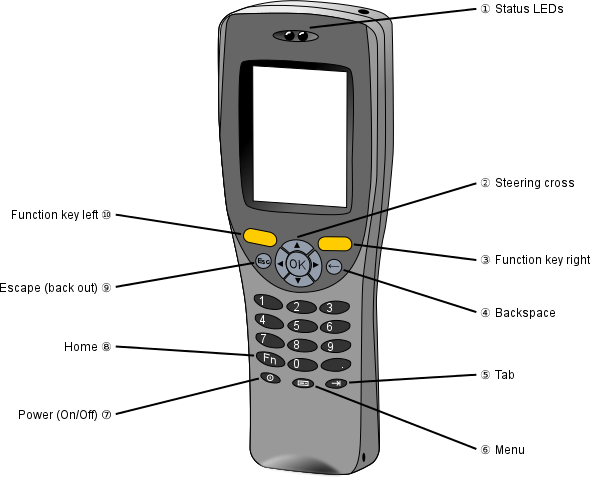Introduction
When development on the MDA Client for Android started in spring of 2012, the skeye.allegro was the only device that matched the requirements of our first customer and was actually available on the real world market.
Unfortunately it has initially been developed for Windows CE 6 and Android 2.3.4 was kind of forced on to the very same hardware which, technically, does not even fulfill the screen resolution requirements for Android 2.3.x.
Quick Start Tips
Read the chapter "Android semantics of skeye.allegro's hardware keys"
See below.
Use keys instead of the touchscreen, particulary steering cross, digits, orange function keys
The allegro has a touchscreen, but using the touchscreen requires both hands and can be quite inefficient in rough environments or when wearing gloves.
Most of the time it's easier to use the steering cross of the physical keyboard. Android's UI supports navigation keys better than one might expect, entering text is the only activity requiring to use the touchscreen.
"OK" clicks/activates a selected object (button, icon, ...), the arrows around it are cursor keys, "Esc" usually means "Back".
MDA additionally supports the two orange function keys. For further information see below.
No SMS-style text entry with numeric keys
The digit keys carry markings suggesting it would be possible to enter text like one is used to do when writing SMS on mobile phones without a touchscreen. Unfortunately this is not possible with Android and the current allegro firmware. Furthermore, the '.'-key cannot be used as comma with some languages settings.
Unlocking the Screen
Take the pen or a finger and "drag" the green thing shown on the touch-sensitive screen from the left side to the right side.
It is also possible to disable the screen locker in the settings.
Android semantics of skeye.allegro's hardware keys
| Android Function | Allegro Key |
|---|---|
| Home | Fn |
| Back | Esc |
| Menu | Menu, center of bottom key row |
MDA support for the orange function keys
Android as operating system and all Android applications we tried so far have no useful function for the two large orange function keys.
MDA however is dedicated to efficient entering of measurement data of considerable numbers of measurements, so we support these two keys for navigation:
- the right function key (labeled ③ in the diagram above) can often be used to go forward to the next page resp. measurement, pressing it has the same effect as touching (clicking) the graphical "next" button displayed on the touch screen.
- the left function key (labeled ⑩ in the diagram above) can often be used to go back to the previous page, pressing it has the same effect as touching (clicking) the graphical "back" button displayed on the touch screen.
The "Esc" button (labeled ⑨ in the diagram above) often has the same effect, but Android's "back" / "back out" semantics furthermore navigates across application layers and even applications.
Known Problems and Solutions
See Known problems of the skeye.allegro.
Making Screenshots
If anybody finds out, please tell us.
